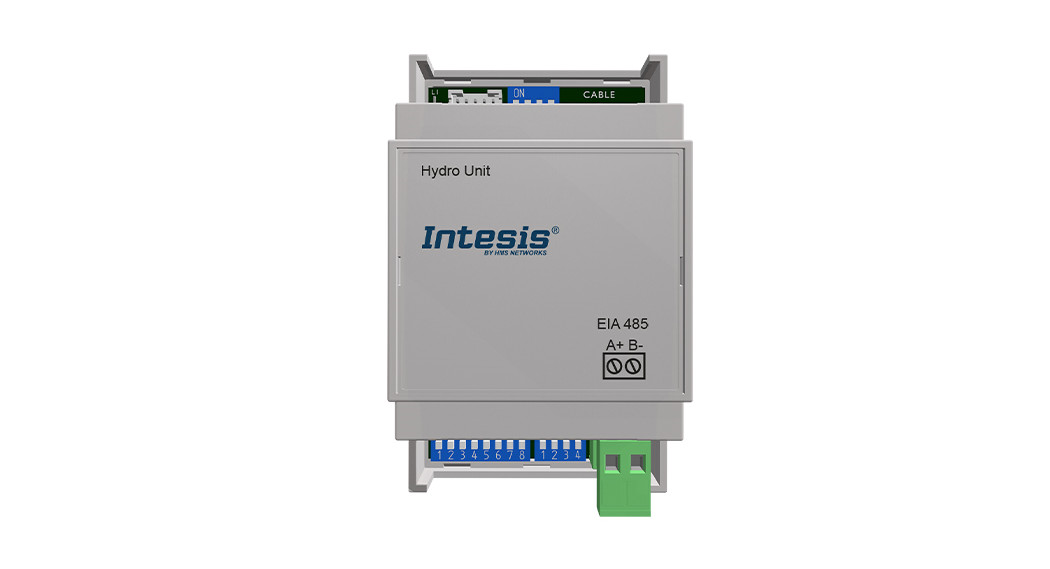 INMBSPAN***O000Panasonic VRF to Modbus Slave orto Home Automation gateway
INMBSPAN***O000Panasonic VRF to Modbus Slave orto Home Automation gateway
Order Code: INMBSPAN***O000** stands for the Intesis gateway capacity and varies depending on the specific gateway acquiredInstallation Sheet rev.1.1HMS Industrial Networks S.L.U. ©
Owner’s RecordThe serial number is located at the rear of the gateway. Record this information in the space provided below. Refer to it whenever you contact your gateway dealer or support team regarding this product.Serial No._________________
SAFETY INSTRUCTIONS
![]()
![]()
CONFIGURATION
Use the Configuration Tool to configure the gateway.See instructions to download and install the latest version at:https://intesis.com/docs/software/intesis-maps-installerUse the Ethernet connection or the Console Port (mini USB type B connector included) to get communication between the gateway and the configuration tool.Follow instructions in the user’s manual for more details.Follow instructions next to properly install the gateway.Disconnect from mains the power supply before connecting it to the Intesis gateway.Disconnect the power of any bus or communication cable before connecting it to the Intesis gateway.Mount the Intesis device on the wall or DIN rail following the instruction given below, respecting the safety instructions given above.Connect an NEC Class 2 or Limited Power Source (LPS) and SELV rated power supply to the Intesis gateway, respect the polarity if DC power or Line and Neutral if AC power. Apply always a voltage within the range admitted by the Intesis gateway and of enough power (see technical characteristics).Circuit-breakers must be used before the power supply. Rating 250V6A.Connect the communication cables to the Intesis device, see details on the user’s manual.Power the Intesis device and the rest of the devices connected to it.NOTE: The device cannot be installed in air-handling space.
Wall Mount
- Separate the fixing clips in the bottom of the box, pushing them to the outside until hearing the “click” which indicates that now the clips are in position for wall mount, see in the figure below.
- Use the holes to fix the box in the wall using screws. Use the template below for the wall wholes.
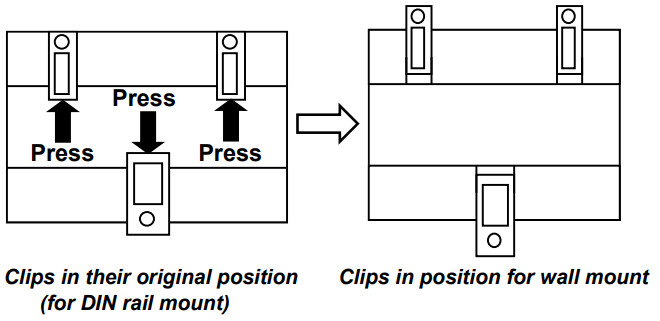

DIN Rail Mount
With the clips of the box in their original position, insert first the box in the upper edge of the DIN rail and later insert the box in the down part of the rail, using a small screwdriver and following the steps in the figure below.
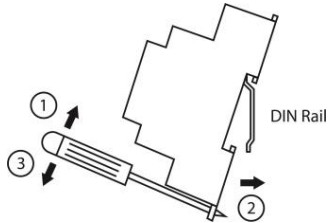

CONNECTIONS
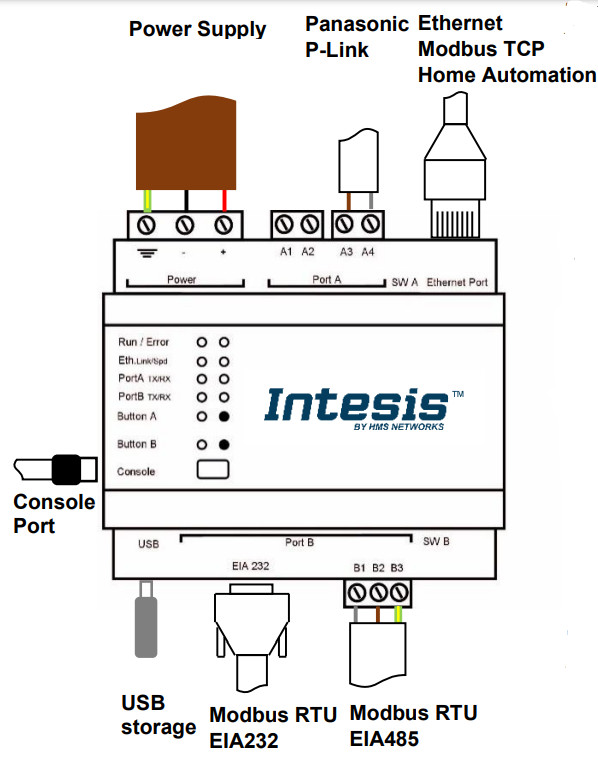

Power SupplyMust use NEC Class 2 or Limited Power Source (LPS) and SELV-rated power supply.If using DC power supply:Respect polarity applied of terminals (+) and (-). Be sure the voltage applied is within the range admitted (check table below). The power supply can be connected to earth but only through the negative terminal, never through the positive terminal.If using AC power supply:Make sure the voltage applied is of the value admitted (24 Vac). Do not connect any of the terminals of the AC power supply to the earth, and make sure the same power supply is not supplying any other device.Ethernet / Modbus TCP (TCP) / Home Automation / Console (UDP & TCP)Connect the cable coming from the IP network to the connector ETH of the gateway. Use an Ethernet CAT5 cable. If communicating through the LAN of the building, contact the network administrator and make sure traffic on the port used is allowed through all the LAN path (check the gateway user manual for more information).Default IP is 192.168.100.246.PortA / P-Link PanasonicConnect the P-Link terminals of the Panasonic Outdoor Unit to the connectors A3 and A4 of the gateway’s PortA. There is no polarity to be respected.PortB / Modbus RTUConnect the EIA485 bus to connectors B1 (B+), B2 (A-), and B3 (SNGD) of the gateway’s PortB. Respect the polarity. Remember the characteristics of the standard EIA485 bus: maximum distance of 1200 meters, maximum 32 devices connected to the bus, and at each end of the bus it must be a termination resistor of 120 Ω. Bus biasing and termination resistor for EIA485 can be enabled for PortB by means of a dedicated DIP switch – see table below.Connect the serial cable EIA232 coming from the external serial device to the EIA232 connector of the gateway’s PortB. This is a DB9 male (DTE) connector in which only the lines TX, RX, and GND are used. Details of the pinout can be seen in the user’s manual. Respect the maximum distance of 15 meters.Console PortConnect a mini-type B USB cable from your computer to the gateway to allow communication between the Configuration Software and the gateway. Remember that Ethernet connection is also allowed. Check the user manual for more information.USBConnect a USB storage device (not an HDD) if required. Check the user manual for more information.
| ELECTRICAL & MECHANICAL FEATURES | |
| Enclosure | Plastic, type PC (UL 94 V-0)Net dimensions (dxwxh): 90x88x56 mmRecommended space for installation (dxwxh): 130x100x100mmColor: Light Grey. RAL 7035 |
| Mounting | Wall.DIN rail EN60715 TH35. |
| Terminal Wiring(for power supplyandlow-voltage signals) | Per terminal: solid wires or stranded wires (twisted or with ferrule)1 core: 0.5mm²… 2.5mm²2 cores: 0.5mm²… 1.5mm²3 cores: not permittedIf cables are more than 3.05 meters long, a Class 2 cable is required. |
| Power | 1 x Plug-in screw terminal block (3 poles)9 to 36VDC +/-10%, Max.: 140mA.24VAC +/-10% 50-60Hz, Max.: 127mARecommended: 24VDC |
| Ethernet | 1 x Ethernet 10/100 Mbps RJ452 x Ethernet LED: port link and activity |
| Port A | 1 x P-Link Plug-in screw terminal block orange (2 poles)1500VDC isolation from other ports1 x Plug-in screw terminal block green (2 poles)Reserved for future use |
| Switch A(SWA) | 1 x DIP-Switch for PORTA configuration:Reserved for future use (leave OFF, default) |
| PORT B | 1 x Serial EIA232 (SUB-D9 male connector) Pinout from a DTE device1500VDC isolation from other ports (except PORT B: EIA485)1 x Serial EIA485 Plug-in screw terminal block (3 poles)A, B, SGND (Reference ground or shield) 1500VDC isolation from other ports (except PORT B: EIA232) |
| Switch B(SWB) | 1 x DIP-Switch for serial EIA485 configuration:Position 1:ON: 120 Ω termination activeOff: 120 Ω termination inactive (default)Position 2-3:ON: Polarization activeOff: Polarization inactive (default) |
| Battery | Size: Coin 20mm x 3.2mmCapacity: 3V / 225mAhType: Manganese Dioxide Lithium |
| Console Port | Mini Type-B USB 2.0 compliant1500VDC isolation |
| USB port | Type-A USB 2.0 compliantOnly for USB flash storage devices (USB pen drive)Power consumption limited to 150mA(HDD connection not allowed) |
| Push Button | Button A: Not usedButton B: Not used |
| OperationTemperature | 0°C to +60°C |
| OperationalHumidity | 5 to 95%, no condensation |
| Protection | IP20 (IEC60529) |
| LEDIndicators | 10 x Onboard LED indicators2 x Run (Power)/Error2 x Ethernet Link/Speed2 x Port A TX/RX2 x Port B TX/RX1 x Button A indicator1 x Button B indicator |
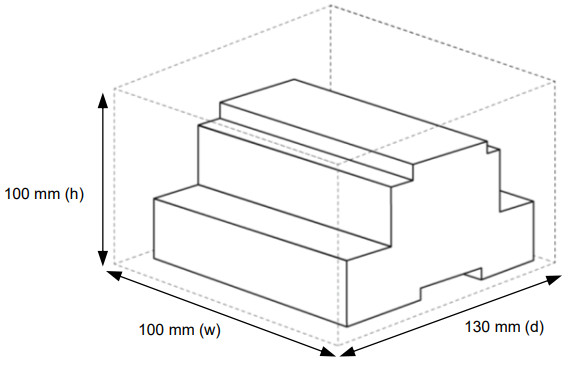






Rev.1.1© HMS Industrial Networks S.L.U – All rights reservedThis information is subject to change without noticeURL https://www.intesis.com
References
[xyz-ips snippet=”download-snippet”]

